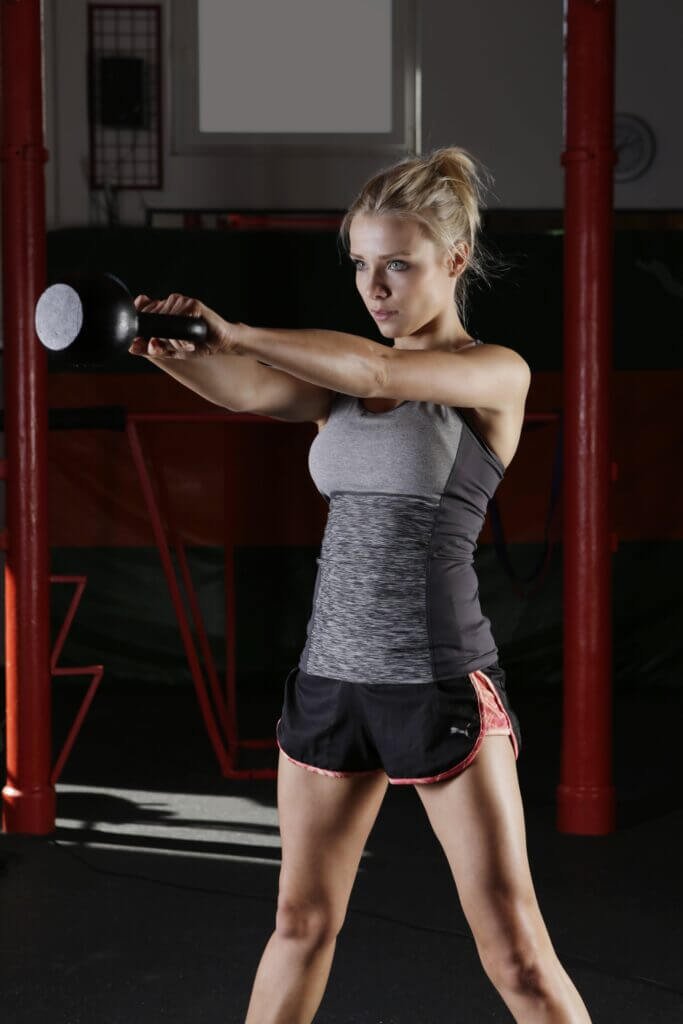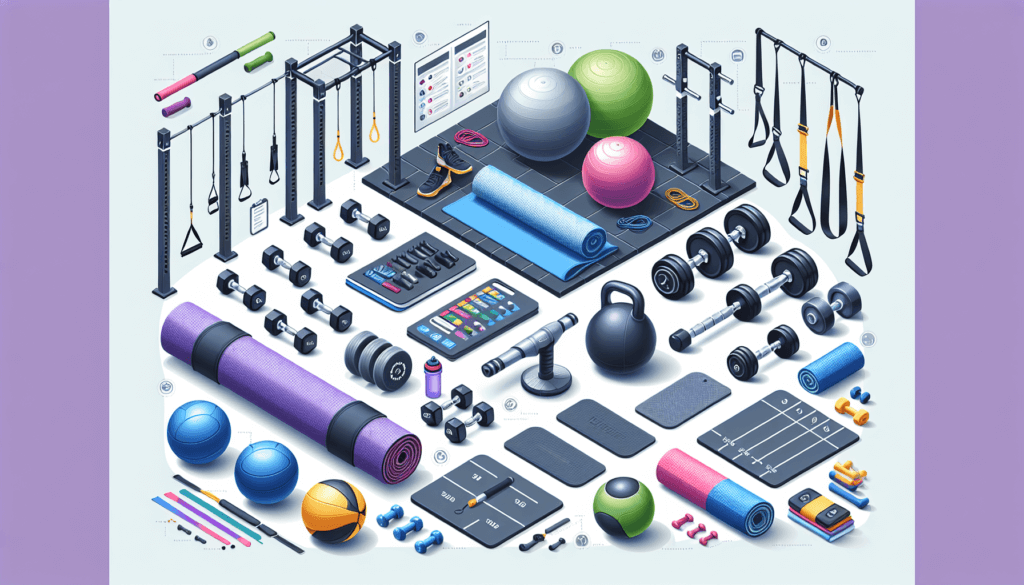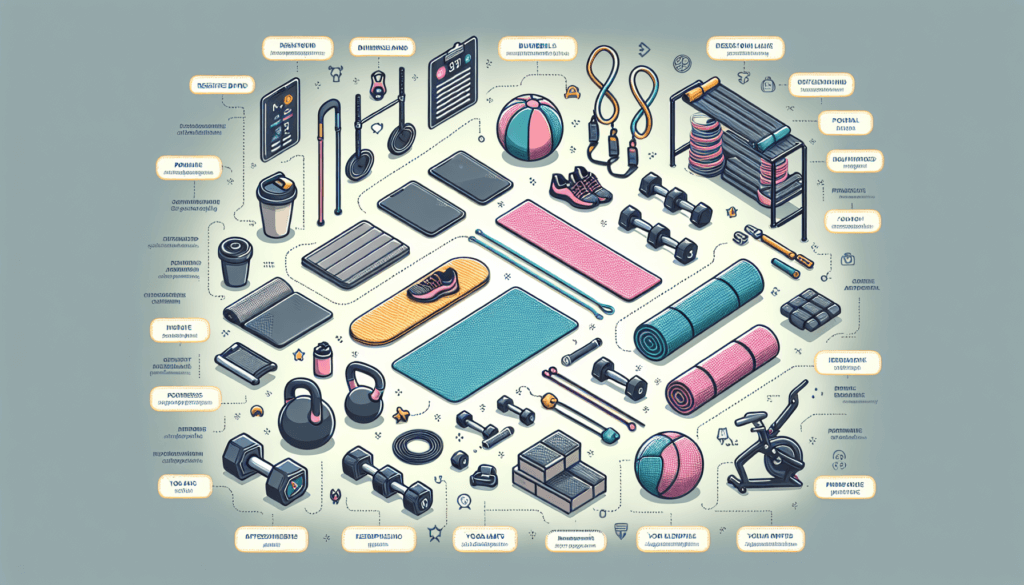If you’re looking to enhance your home gym experience, then you’ve come to the right place! In this article, we’ll be exploring some of the most popular workout accessories that are perfect for home gyms. These amazing tools will not only elevate your workout routine but also help you achieve your fitness goals with ease. From resistance bands to adjustable dumbbells and yoga mats, we’ve got you covered. Let’s dive into the world of popular workout accessories and transform your home gym into a fitness haven.

Resistance Bands
Resistance bands are a versatile and popular piece of workout equipment that can be used for a variety of exercises. They are available in different types, each offering unique benefits for your fitness routine.
Types of Resistance Bands
There are several types of resistance bands available on the market. The most common types include loop bands, tube bands, and therapy bands. Loop bands are perfect for lower body exercises, such as squats and glute bridges. Tube bands, which often come with handles, can be used for a wide range of exercises targeting different muscle groups. Therapy bands are typically used for rehabilitation purposes and are often made of latex or rubber.
Benefits of Resistance Bands
Resistance bands offer various benefits that make them a great addition to any home gym setup. They are lightweight, portable, and easy to store, making them perfect for those who have limited space. They are also highly versatile, allowing you to target specific muscle groups and adjust the resistance level according to your fitness level. Resistance bands can also be used for both strength training and rehabilitation exercises, making them suitable for individuals of all fitness levels.
Exercises with Resistance Bands
Resistance bands can be used for a wide range of exercises, targeting different muscle groups. Some common exercises include bicep curls, tricep extensions, chest presses, rows, and lateral band walks. They can also be used for lower body exercises, such as lunges and glute bridges. Additionally, resistance bands can be incorporated into cardio workouts by performing exercises like mountain climbers or squat jumps with the bands around your thighs.
How to Choose the Right Resistance Bands
When choosing resistance bands, there are a few factors to consider. Firstly, you should consider the resistance level. Bands typically come in different colors or levels of resistance ranging from light to heavy. It’s important to choose a band that provides enough resistance to challenge your muscles but not too much that it becomes difficult to perform the exercises correctly. Additionally, check the durability and quality of the bands to ensure they will last long and not snap during workouts. Lastly, consider whether you prefer loop bands, tube bands, or therapy bands based on your specific exercise needs.
Adjustable Dumbbells
Adjustable dumbbells are a convenient and space-saving alternative to traditional dumbbells. They offer a wide range of benefits and are a popular choice for home gym enthusiasts.
Benefits of Adjustable Dumbbells
One of the main benefits of adjustable dumbbells is their versatility. With just one set of adjustable dumbbells, you can adjust the weight according to your desired intensity for various exercises. This means you don’t need to purchase multiple sets of dumbbells, saving both space and money. Adjustable dumbbells also allow for quick weight changes, making it easy to transition between different exercises without wasting time.
Popular Brands of Adjustable Dumbbells
There are several reputable brands that offer high-quality adjustable dumbbells. Some popular brands include Bowflex, PowerBlock, and NordicTrack. These brands are known for their durable construction, smooth weight adjustment systems, and comfortable grip handles. It’s important to choose a brand that suits your preferences and budget, ensuring you get the best value for your money.
Choosing the Right Weight Range for Adjustable Dumbbells
When selecting adjustable dumbbells, it’s important to consider the weight range that suits your fitness goals and strength level. Adjustable dumbbells typically come in different weight increments, ranging from light to heavy. If you are a beginner, it’s advisable to start with a lower weight range and gradually increase the weight as you progress. On the other hand, if you are more advanced, you may want to choose adjustable dumbbells with a wider weight range to accommodate your strength and training needs.

Yoga Mat
A yoga mat is an essential accessory for yoga enthusiasts of all levels. It provides a comfortable and stable surface for practicing different yoga poses and exercises.
Features of a Quality Yoga Mat
A quality yoga mat should have certain features to enhance your yoga practice. Firstly, it should offer sufficient thickness and cushioning to provide comfort and support for your joints and bones. A mat that is too thin may cause discomfort during kneeling or prone positions. Additionally, the mat should have good traction to prevent slipping and sliding during poses or challenging sequences. Look for mats made from non-slip materials or those with a textured surface for better grip.
Different Types of Yoga Mats
Yoga mats come in various types, each catering to specific needs and preferences. PVC mats are the most common and widely available, offering durability, cushioning, and good traction. However, if you are concerned about the environmental impact, you can opt for eco-friendly mats made from materials like natural rubber or cork. These mats are biodegradable and have excellent grip. Other types of yoga mats include travel mats, which are thin and lightweight for easy portability, and extra-thick mats for added joint support.
Benefits of Using a Yoga Mat
Using a yoga mat has several benefits for your yoga practice. Firstly, it provides a dedicated and clean space for your practice, away from the distractions of the floor or carpet. The cushioning of the mat helps to reduce the impact on your joints, making your practice more comfortable. Additionally, the texture and grip of the mat allow you to maintain stability and balance during different poses and movements. A yoga mat also helps to define your personal space, creating a sense of boundaries for your practice.
Cleaning and Maintenance Tips for Yoga Mats
To keep your yoga mat clean and hygienic, regular cleaning and maintenance are necessary. You can start by wiping down the mat with a damp cloth or using a mat spray after each practice. For a deeper clean, you can hand wash the mat using a gentle detergent and warm water. After washing, ensure the mat is thoroughly dried before rolling it up to prevent the growth of mold or mildew. Avoid using harsh chemicals or abrasive scrubbers that can damage the mat’s surface.
Jump Rope
Jumping rope is a fun and effective way to incorporate cardiovascular exercise into your fitness routine. It is an excellent workout accessory for home gyms, offering various benefits for your overall fitness.
Types of Jump Ropes
There are different types of jump ropes available, each suited for different purposes and skill levels. Basic jump ropes are the most common and affordable, consisting of a simple rope with plastic or wooden handles. Speed ropes are designed for those who want to perform fast-paced, high-intensity jump rope workouts. These ropes have lightweight handles and thin cables, allowing for quick rotations. Weighted jump ropes have additional weight in the handles or cables, increasing the intensity of your workout and providing resistance.
Benefits of Jump Rope Workouts
Jump rope workouts offer a wide range of benefits for your cardiovascular health and overall fitness. Jumping rope is a high-impact exercise that helps strengthen your bones and improve bone density. It also provides an effective cardio workout, helping to improve your heart health and endurance. Jump rope workouts can burn a significant amount of calories, making it an efficient option for weight loss or weight management. Additionally, jumping rope can improve coordination, agility, and rhythm.
Jump Rope Techniques and Exercises
Jumping rope involves various techniques and exercises that can challenge different muscle groups and improve your jump rope skills. Some common techniques include basic jumps, alternate foot jumps, double unders, and crossover jumps. These techniques can be combined to create jump rope workouts with a variety of intensity levels and difficulty. Jump rope exercises can also be modified by incorporating different variations, such as single leg jumps, high knees, or side swings, to target specific areas or add variety to your workouts.
Choosing the Right Length of Jump Rope
Choosing the correct length of jump rope is essential for an efficient and safe workout. To determine the proper length, stand on the middle of the rope and pull the handles up towards your armpits. The handles should reach your armpits or slightly below. This length allows for proper rotation, preventing the rope from hitting the ground too early or too late. If you are unsure, it’s better to choose a longer rope and adjust the length accordingly, as it is easier to shorten a rope than to lengthen it.

Foam Roller
Foam rolling has become an increasingly popular practice for muscle recovery and self-myofascial release. Foam rollers are cylindrical tools that help alleviate muscle tension and promote muscle flexibility.
Benefits of Foam Rolling
Foam rolling offers numerous benefits for your muscles and overall well-being. When used regularly, foam rolling can help reduce muscle soreness and stiffness, enhancing post-workout recovery. It helps break up adhesions and knots in the fascia, the connective tissue surrounding your muscles, promoting better blood circulation and range of motion. Foam rolling can also help improve muscle imbalances and correct postural issues by releasing tension in specific areas. Additionally, foam rolling can promote relaxation and reduce stress, making it a valuable addition to your self-care routine.
Different Types of Foam Rollers
Foam rollers come in various densities and textures, each providing a different level of intensity and targeting specific muscle groups. The most common type of foam roller is made of high-density foam, which offers a moderate amount of pressure and is suitable for most individuals. For those who prefer a deeper massage, there are firm foam rollers made of dense EVA foam or molded plastic. These rollers apply more intense pressure and are ideal for individuals with thicker muscle tissue or those who require a more aggressive release. Some foam rollers also have textured surfaces, such as knobs or ridges, which can provide additional stimulation and target specific points.
How to Use a Foam Roller for Muscle Recovery
Using a foam roller for muscle recovery is relatively simple and can be incorporated into your post-workout routine. Start by placing the foam roller on the floor and positioning the targeted muscle group on top of it. Apply gentle pressure and roll the foam roller back and forth, moving slowly to search for areas of tightness or discomfort. When you find a tight spot, hold the pressure for 20-30 seconds to allow the muscle to release and relax. It’s important to breathe deeply and avoid rolling directly over joints or bony areas. Foam rolling can be done immediately after a workout or as part of a stretching routine.
Factors to Consider When Buying a Foam Roller
When choosing a foam roller, there are a few factors to consider to ensure you select the right one for your needs. First, consider the density and firmness of the foam roller. If you are a beginner or prefer a less intense massage, opt for a softer foam roller. More experienced users or those with specific areas of tension may prefer a firmer roller. Additionally, consider the size and length of the foam roller. Longer foam rollers offer more stability and coverage, while smaller ones are more portable and suitable for targeted areas like the calves or arms. Lastly, think about the durability and quality of the foam roller, as well as any specialized features like vibration or heat therapy options, depending on your preferences and budget.
Exercise Ball
An exercise ball, also known as a stability ball or Swiss ball, is a versatile and effective tool for improving balance, stability, and core strength. It can be used for a wide range of exercises and workouts.
Benefits of Exercise Balls
Using an exercise ball offers several benefits for your overall fitness and well-being. One of the main benefits is improved core strength and stability. Sitting or performing exercises on an unstable surface engages the deep muscles of your core, helping to build strength and improve balance. Exercise balls can also enhance flexibility and range of motion by challenging different muscle groups. Using an exercise ball during workouts can improve posture and alignment, as it requires proper spinal alignment for balance. Additionally, exercise balls are effective tools for rehabilitation exercises, promoting joint stability and gentle strengthening.
Choosing the Right Size of Exercise Ball
Choosing the correct size exercise ball is crucial for safety and comfort during workouts. Exercise balls come in different sizes, typically determined by the diameter of the ball. To find the right size, consider your height as a guideline. If you are between 4’10” and 5’5″, a 55 cm ball is suitable. For heights between 5’6″ and 6’0″, a 65 cm ball is recommended. If you are taller than 6’0″, a 75 cm ball is the appropriate size. It’s important to note that these are general guidelines, and individuals with longer legs or shorter torsos may need to adjust the ball size accordingly.
Exercises and Workouts with an Exercise Ball
Exercise balls can be used for a variety of exercises targeting different muscle groups and fitness goals. They are particularly effective for core exercises, such as plank variations, crunches, and back extensions. Exercise balls can also be incorporated into upper body exercises like push-ups, tricep dips, and shoulder presses. Additionally, exercise balls can be used for lower body exercises, such as squats, lunges, and hamstring curls. They can also be beneficial for stretching exercises and balance training. There are numerous exercise ball workout routines available online that provide step-by-step instructions and variations.
Safety Tips for Using an Exercise Ball
When using an exercise ball, it’s important to prioritize safety to prevent injuries. Start by ensuring that the exercise ball is properly inflated and supporting your weight. If the ball feels too soft or squishy, it may not provide enough stability. Conversely, if it feels too firm, it may be overly rigid and uncomfortable. Additionally, always maintain proper form and alignment during exercises, engaging your core muscles for stability. It’s advisable to start with beginner-level exercises and gradually progress to more challenging ones as your strength and stability improve. Lastly, avoid using the exercise ball on slippery or uneven surfaces to prevent accidents and falls.

Fitness Tracker
Fitness trackers have gained popularity in recent years as effective tools for monitoring and tracking your fitness progress. They offer a range of features and capabilities that can assist you in achieving your health and fitness goals.
Features to Look for in a Fitness Tracker
When choosing a fitness tracker, it’s important to consider the features that align with your specific needs and goals. Basic features include step counting, distance tracking, and calorie counting, which provide a comprehensive overview of your daily activity level. Heart rate monitoring is another important feature that allows you to track your heart rate during workouts and ensure you are working within your target heart rate zone. Sleep tracking is also a valuable feature that provides insight into your sleep patterns and quality. Additionally, consider features like GPS tracking, waterproof design, and compatibility with smartphone apps or fitness platforms.
Top Fitness Tracker Brands
There are several well-known brands that offer high-quality fitness trackers. Some of the top brands include Fitbit, Garmin, and Apple. Fitbit is known for its user-friendly interface and accurate tracking capabilities. Garmin offers a wide range of fitness trackers that cater to different fitness levels and preferences. Apple’s smartwatches provide a comprehensive set of features, including fitness tracking, heart rate monitoring, and connectivity with other Apple devices. It’s important to choose a brand that suits your preferences and integrates well with your existing devices or fitness ecosystem.
Tracking and Analyzing Your Workouts with a Fitness Tracker
One of the primary functions of a fitness tracker is to track and analyze your workouts. Fitness trackers can automatically detect different types of activities, such as walking, running, or cycling, and provide detailed reports on your performance. They can track metrics like distance covered, pace, heart rate, and calories burned. Many fitness trackers also offer coaching features that provide real-time feedback and guidance during workouts. The data collected by fitness trackers allows you to monitor your progress over time, set specific goals, and make adjustments to your training routine for optimal results.
Battery Life and Connectivity Options
Battery life and connectivity options are important considerations when choosing a fitness tracker. Most fitness trackers offer a battery life of several days to a week, depending on the features used and frequency of use. Some advanced models have longer battery life, while others may require more frequent charging. Additionally, consider the charging mechanism, whether it is via a USB cable or a dedicated charging dock. Depending on your preferences, look for fitness trackers that offer wireless connectivity options such as Bluetooth or Wi-Fi, allowing you to sync your data with other devices or fitness apps easily. Compatibility with smartphone operating systems, such as iOS or Android, is also essential for seamless integration with your existing devices.
Resistance Loop Bands
Resistance loop bands, also known as mini bands or booty bands, are smaller versions of resistance bands that provide added resistance for various exercises. They are particularly popular for lower body workouts and can offer unique benefits for your fitness routine.
Benefits of Resistance Loop Bands
Resistance loop bands offer several benefits that make them a valuable addition to your workout routine. They are highly portable and easy to pack, making them ideal for on-the-go workouts or travel. Resistance loop bands are versatile and can be used for a wide range of exercises targeting different muscle groups, particularly the lower body. They provide constant tension throughout the range of motion, engaging the muscles more effectively and promoting muscle growth and strength. Additionally, resistance loop bands can be used to activate and strengthen smaller stabilizing muscles, which are often neglected during traditional resistance training exercises.
Exercises and Workouts with Resistance Loop Bands
Resistance loop bands can be used for a variety of lower body exercises that target the glutes, hips, thighs, and calves. Some common exercises include squats, glute bridges, lateral walks, clamshells, and leg curls. These exercises can be performed with or without additional weights, depending on your fitness level and goals. Resistance loop bands can also be incorporated into full-body workouts by using them for upper body exercises like bicep curls, shoulder presses, or tricep extensions. There are countless resistance loop band workout routines available online that cater to different fitness levels and objectives.
Choosing the Right Resistance Level
Resistance loop bands typically come in different resistance levels or colors to accommodate different fitness levels and exercise needs. It’s important to choose the right resistance level to ensure an effective and safe workout. If you are a beginner or recovering from an injury, start with a lighter resistance band and gradually progress to higher resistance levels. As a general guideline, yellow or light-colored bands offer the lowest resistance, while black or dark-colored bands offer the highest resistance. It’s important to listen to your body and choose a resistance level that challenges your muscles without causing pain or discomfort.
Durability and Longevity of Resistance Loop Bands
The durability and longevity of resistance loop bands depend on the quality of the bands and how well they are cared for. Look for bands made from durable and high-quality materials, such as natural latex or rubber, which are less likely to break or snap during use. It’s important to inspect the bands regularly for any signs of wear and tear or damage and replace them if necessary. To prolong the lifespan of the bands, avoid exposing them to extreme temperatures or direct sunlight, as this can cause the bands to deteriorate more quickly. Additionally, store the bands in a cool and dry place to prevent moisture buildup or deformation.

Pull-Up Bar
A pull-up bar is a simple yet effective piece of equipment that allows you to perform one of the most challenging and beneficial upper body exercises – the pull-up. It offers numerous benefits for your upper body strength and overall fitness.
Different Types of Pull-Up Bars
There are different types of pull-up bars available, each offering unique features and installation options. Doorway-mounted pull-up bars are the most common and convenient type, as they can be easily installed in a doorway without the need for permanent fixtures. They typically have extendable bars that fit securely between the door frame. Wall-mounted pull-up bars are more robust and offer greater stability, as they are mounted directly onto the wall studs. Ceiling-mounted pull-up bars are ideal for those with high ceilings or ample overhead space. Free-standing pull-up bars are standalone structures that do not require any installation and can be moved to different locations.
Benefits of Pull-Up Exercises
Pull-up exercises are highly effective for developing upper body strength, particularly in the back, arms, and shoulders. They target the latissimus dorsi, also known as the lats, which are the largest muscles in the back. Pull-ups also engage the biceps, forearms, and core muscles, providing a comprehensive upper body workout. By regularly incorporating pull-ups into your routine, you can improve your grip strength, posture, and overall upper body muscular development. Pull-ups are a compound exercise that requires the activation of multiple muscle groups, making them efficient in terms of time and energy expenditure.
Installing and Using a Pull-Up Bar
Installing a pull-up bar depends on the type of bar you choose. For doorway-mounted bars, follow the specific instructions provided with the bar to ensure proper installation. Ensure that the bar is securely attached and able to support your body weight. For wall-mounted or ceiling-mounted bars, it’s advisable to consult a professional to ensure safe and secure installation. When using a pull-up bar, start by standing on a stable surface and gripping the bar with an overhand grip, slightly wider than shoulder-width apart. Hang from the bar with your arms fully extended, engage your core, and pull yourself up towards the bar until your chin clears the bar. Lower yourself back down with control and repeat for the desired number of repetitions.
Weight Limit and Safety Considerations
When using a pull-up bar, it’s important to consider the weight limit and safety precautions to ensure a safe and effective workout. Before using a pull-up bar, check the manufacturer’s weight limit guidelines to ensure that it can safely support your body weight. It’s also crucial to inspect the bar regularly for any signs of wear and tear or damage and replace it if necessary. To prevent accidents or injuries, always warm up before performing pull-ups and use proper form and technique throughout the exercise. If you are new to pull-ups or have limited upper body strength, consider starting with assisted pull-up variations using a resistance band or utilizing a pull-up assist machine to gradually build strength.


